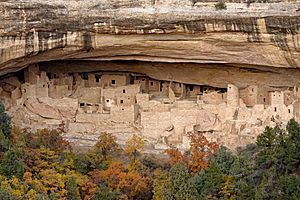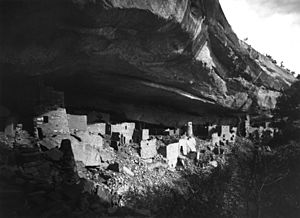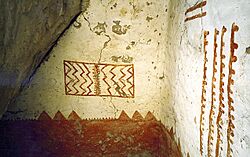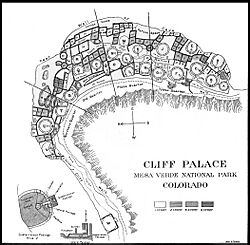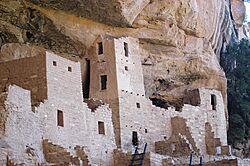Cliff Palace facts for kids
Cliff Palace is an amazing ancient village built right into the side of a cliff! It's the biggest cliff dwelling in all of North America. This incredible place was built by a group of people called the Ancestral Puebloans long ago.
You can find Cliff Palace in Mesa Verde National Park in Colorado, USA. This area was once the homeland of the Ancestral Puebloans. The park and the cliff dwelling are located in Montezuma County, in the southwestern part of Colorado.
Contents
History of Cliff Palace
Scientists can tell how old buildings are by looking at tree rings. This method is called tree-ring dating. It shows that people built and fixed up Cliff Palace between about 1190 AD and 1260 AD. Most of the building work happened in just 20 years!
The Ancestral Puebloans built Cliff Palace and other similar homes in Mesa Verde. They moved to these cliff homes because they offered good protection. There was also more competition for resources and the weather was changing.
People left Cliff Palace by the year 1300. Experts are still discussing why they left. Some believe that long periods of very dry weather, called megadroughts, made it hard to grow food. This might have forced them to move.
Cliff Palace was found again in 1888. Two men, Richard Wetherill and Charlie Mason, discovered it. They were actually looking for their lost cattle at the time!
What Cliff Palace Looks Like
Cliff Palace was mostly built using sandstone, mortar, and wooden beams. The builders shaped the sandstone with harder stones. They used a mix of soil, water, and ash as mortar to hold the stones together. Smaller "chinking" stones filled gaps to make the walls strong.
Many walls were once covered with colorful plaster made from earth. Over time, this plaster wore away.
Doorways and Rooms
Visitors often notice that the doorways at Cliff Palace are quite small. This is because people were generally shorter back then. The average man was under 5 feet 6 inches tall, and the average woman was closer to 5 feet tall.
Cliff Palace has 150 rooms and 23 kivas. Kivas are special round, sunken rooms used for ceremonies. About 100 people lived here.
One kiva is right in the middle of the ruins. A series of walls divides the whole structure at this point. These walls have no doorways or other ways to pass through. The walls of this kiva were plastered with different colors on each side.
Experts think Cliff Palace was an important place for social gatherings and managing the community. It was also used for many ceremonies.
Clans and Community Life
Archaeologists believe that more family groups, or clans, lived in Cliff Palace than in other nearby Mesa Verde communities. This idea comes from looking at the number of rooms compared to kivas.
Cliff Palace has about 9 rooms for every kiva. In most Mesa Verde communities, there are about 12 rooms for every kiva. Having more kivas might mean that Cliff Palace was a central place for many smaller communities around it.
The Tall Tower
To the right side of Cliff Palace, there is a large square tower. It almost reaches the cave's "roof." By the 1800s, this tower was in ruins.
The National Park Service carefully rebuilt it to its original height and look. This makes it one of the most memorable buildings at Cliff Palace. It is the tallest structure in Mesa Verde, standing 26 feet high with four levels. Slightly different colored materials were used in the restoration to show which parts were rebuilt.
-
Round tower, Cliff Palace in 1941.
A 1941 photograph of Cliff Palace by Ansel Adams.
See also
 In Spanish: Cliff Palace para niños
In Spanish: Cliff Palace para niños


